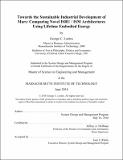Towards the sustainable industrial development of Mars : comparing novel ISRU / ISM architectures using lifetime embodied energy
Author(s)
Lordos, George C
DownloadFull printable version (5.998Mb)
Advisor
Jeffrey A. Hoffman.
Terms of use
Metadata
Show full item recordAbstract
Aerospace engineers use mass (e.g. IMLEO) as a reliable proxy for space mission costs in space system architecture and trade studies. However, in recent years, the true cost of human space exploration architectures is progressively being decoupled from IMLEO, mainly as a result of reusable rockets, adoption of ISRU and ISM, and a new emphasis on developing permanent infrastructure on other worlds. This thesis investigates the case for adopting embodied energy as a novel and more capable metric for the value and cost of in-space activities. Energy is the natural metric for work, and all in-space activities require costly direct and indirect energy sources. Embodied energy is an objective metric of cumulative past work, first developed by ecologists and economists in the 1970's and mainly used today to evaluate the lifecycle energy performance of buildings. The embodied energy expended in space logistics is proposed as the primary source of embodied energy for all in-space activities, coupling the proposed new method with currently accepted practice of mass minimization. Howard Odum's energy language, which charts flows of embodied energy from sources to producers, consumers and sinks, is adapted for use in the design of an early industrial outpost on Mars. A case study of seven scenaria for this simple Mars outpost over 20 and 40 years, all with identical IMLEO but widely varying embodied energies, is used to demonstrate how embodied energy leads to superior system-wide architectural insights in the design of sustainable, permanent human outposts on other worlds. An early finding is that lifetime embodied energy cost reductions increase with the time horizon and the up-front investment in ISRU and ISM capabilities. Future work based on lifetime embodied energy may result in new approaches for the simultaneous optimization of lifetime emplaced and logistical masses, lifetime energy efficiency and other figures of merit for long term system performance. The proposed Lifetime Embodied Energy metric supports the development of improved methods and tools for the system design of human outposts on other worlds. Improved system design may in turn contribute to the outposts' sustainable growth in an organic manner, and shorten the time between their establishment and Earth independence.
Description
Thesis: S.M. in Engineering and Management, Massachusetts Institute of Technology, System Design and Management Program, 2018. This electronic version was submitted by the student author. The certified thesis is available in the Institute Archives and Special Collections. Cataloged from student-submitted PDF version of thesis. Includes bibliographical references (pages 101-103).
Date issued
2018Department
Massachusetts Institute of Technology. Engineering and Management ProgramPublisher
Massachusetts Institute of Technology